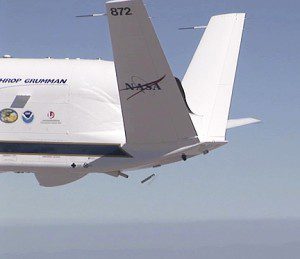
A NASA Global Hawk releases a dropsonde, a device that measures storm conditions as it falls to the ground.
In August 2013, NASA will begin flying two Global Hawk unmanned aircraft in an intensive campaign to gain insight into the dynamics of hurricane intensity change in the Atlantic Ocean basin.
For the HS3 mission, scheduled to begin Aug. 20 and run through Sept. 23, NASA plans to fly two Global Hawks equipped with instruments to measure atmospheric humidity, pressure, temperature, aerosols and wind speed.
One aircraft features instruments designed to gather data while peering down through clouds and precipitation at the guts of the storm, said Bernadette Luna, HS3 deputy project manager at NASA Ames. That instrument suite, dubbed the Over-Storm Payload, features a conically scanning Doppler radar, known as High-Altitude Imaging Wind and Rain Airborne Profiler; a multifrequency interferometric radiometer, called Hurricane Imaging Radiometer; and the High Altitude Monolithic Microwave integrated Circuit Sounding Radiometer.
The second HS3 aircraft is equipped with sensors to observe atmospheric conditions in the immediate vicinity of the storm. The Environmental Payload on that aircraft features the High-resolution Interferometer Sounder to provide data on atmospheric temperature and water vapor; an airborne Doppler lidar, called Tropospheric Wind Lidar Technology Experiment; the Cloud Physics Lidar; and dropsondes, devices created by the National Center for Atmospheric Research to measure storm conditions as they fall from aircraft to the ground.
Image courtesy of NOAA/NASA.

